See Andromeda Galaxy Through Telescope
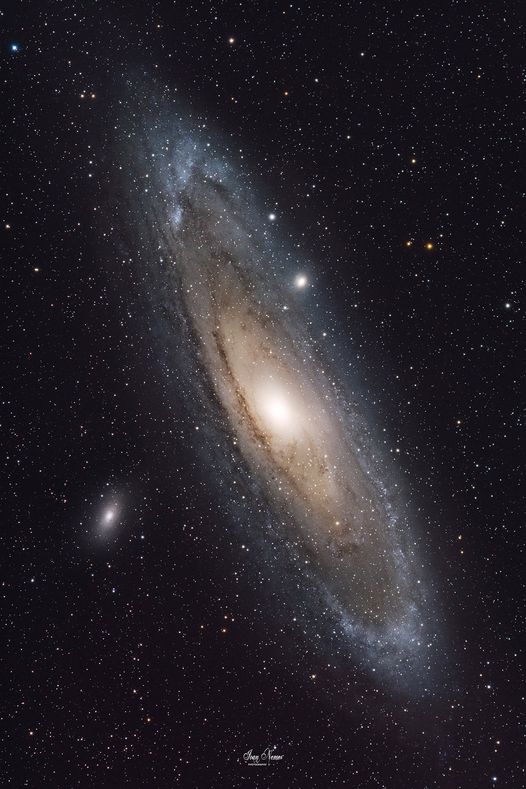
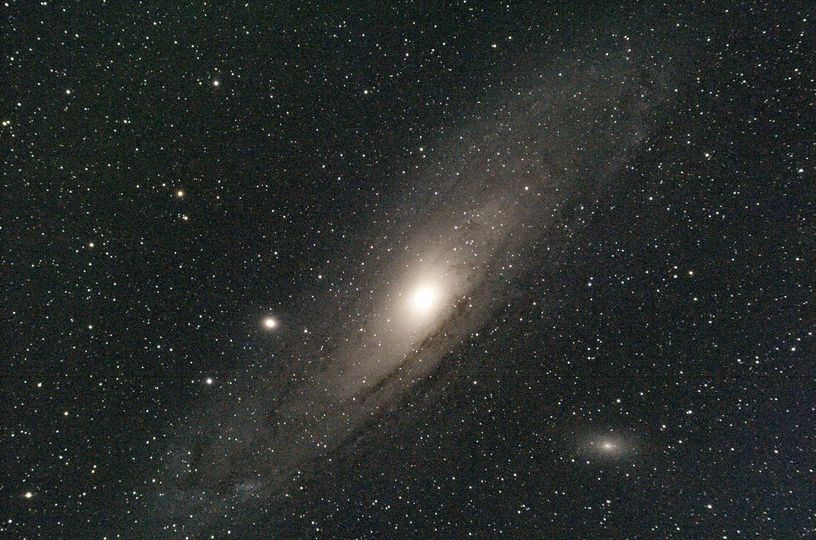
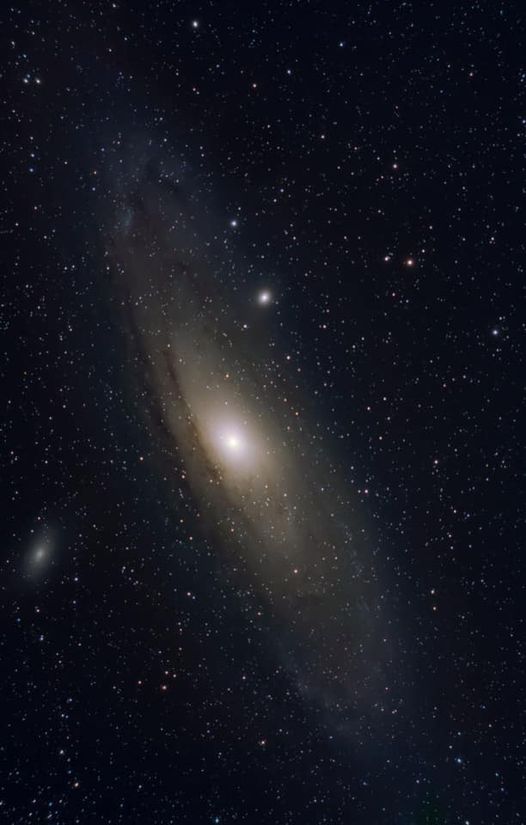
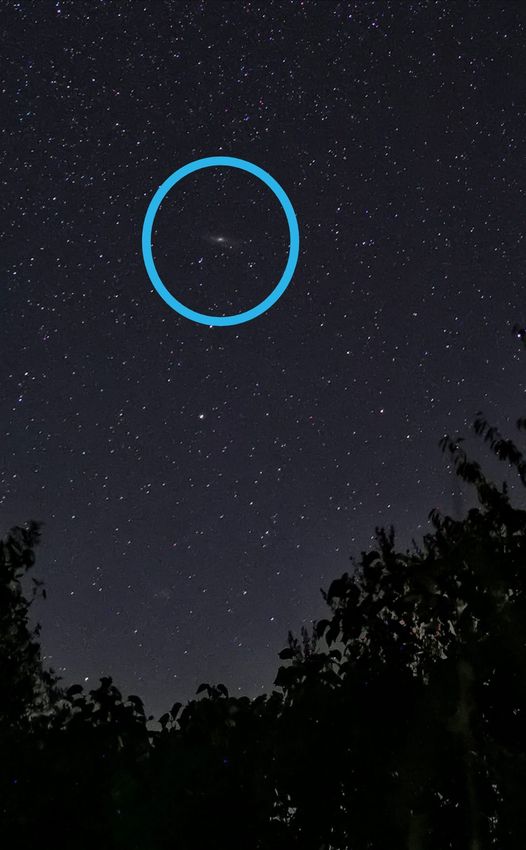
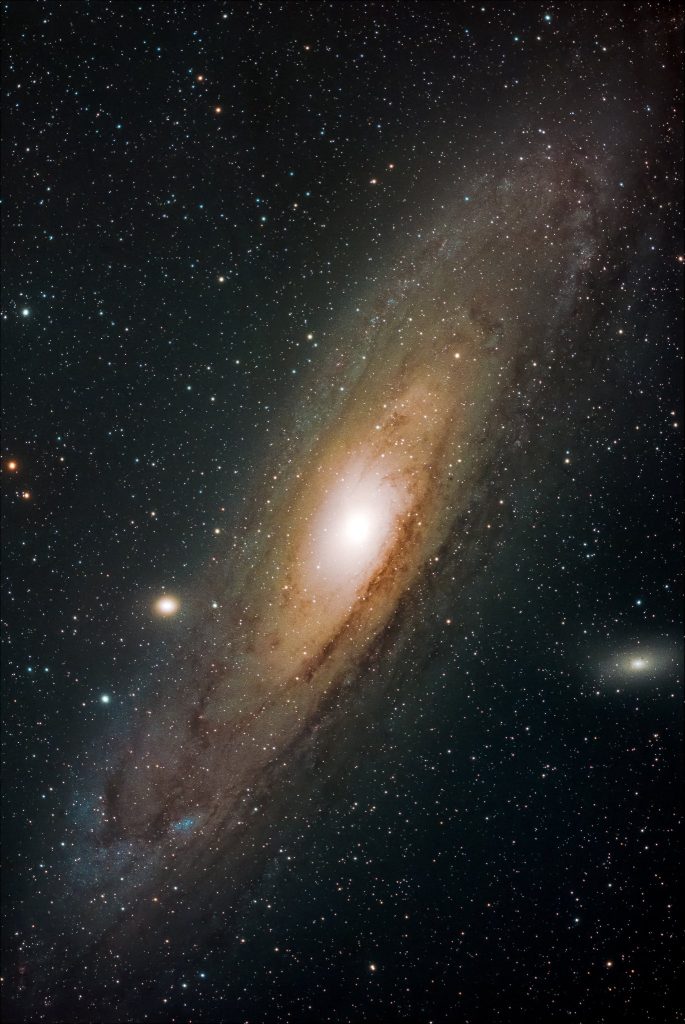
The Andromeda Galaxy is a distant celestial object. Andromeda can be viewed from Earth using a telescope of the right size. Even amateur astronomers can enjoy a stunning view of Andromeda with a moderate-sized telescope, specifically one with an aperture of 6-8 inches (15-20 cm). This size is ideal for gathering enough light to reveal the galaxy’s details without an excessively large field of view. Popular telescope models like those from the Celestron brand often fall within this range. Viewing Andromeda through a telescope transforms it from a mere fuzzy patch into a breathtaking sight, allowing one to observe its central bulge and even spot some of its satellite galaxies.
When observed through a telescope, the Andromeda Galaxy appears as a faint, fuzzy, elliptical patch in the sky. The central region (M31) is brighter and gives it a subtle, mottled appearance. Using a moderate-sized telescope, the galaxy’s core is revealed as a small, bright nucleus surrounded by a faint, diffuse halo. Under ideal viewing conditions, a larger telescope can reveal some of Andromeda’s structural features in more detail, such as a bright central nucleus, a faint, diffuse halo, and larger star clusters, nebulae, or dust lanes.
To see the Andromeda Galaxy, one should choose a telescope with a minimum aperture of 60mm, preferably larger, and a short focal length between 500mm to 700mm. Reflector telescopes are ideal for observing galaxies like Andromeda. Popular choices include the Celestron NexStar 130mm and Orion 8945 SkyQuest XT8. The optimal magnification range is between 100x and 200x, achieved using eyepieces with focal lengths between 10mm and 20mm. Binoculars can complement telescopes by providing a wider field of view.
To view the Andromeda Galaxy, find a dark location with minimal light pollution during the autumn and winter months. Look for the constellation Andromeda between Cassiopeia and Pegasus. Start with a low-power eyepiece to find the galaxy, then switch to a higher-power eyepiece for better observation. Use a finder scope or red dot sight to accurately point your telescope at the Andromeda galaxy. Observe the galaxy on a clear, dark night, avoiding periods with a full moon, and when it’s highest in the sky.
Can you see Andromeda with a telescope?
Yes, you can see the Andromeda Galaxy through a telescope. Andromeda is one of the most distant celestial objects visible from Earth. The Andromeda Galaxy is best viewed using a telescope of the right size.
A telescope with an aperture of 6-8 inches (15-20 cm) is ideal for viewing the Andromeda Galaxy. This size is needed to gather enough light to reveal the galaxy’s details without overwhelming the observer with an excessively large field of view. Popular Celestron telescope models often fall within this range and are perfect for amateur astronomers looking to explore the cosmos from their own backyard.
Through a telescope, the Andromeda Galaxy transforms from a mere fuzzy patch into a breathtaking sight. You can observe its central bulge and even spot some of its satellite galaxies. Spanning about 3° x 1° in the sky, it is roughly six times the diameter of the full Moon. A telescope allows you to view Andromeda in a way that is simply not possible with the naked eye, revealing the galaxy’s structures and features that would otherwise remain hidden. This makes the experience of seeing Andromeda thru a telescope an unforgettable journey for any stargazer.
Can you see Andromeda without a telescope?
Yes, it is indeed possible for an individual with average vision to see the Andromeda Galaxy without the aid of a telescope. Andromeda galaxy is located approximately 2.537 million light-years from Earth. Andromeda holds the distinction of being the most distant object visible to the naked eye. The Andromeda Galaxy (M31) appears as a faint, fuzzy patch within the constellation Andromeda. Andromeda is prominently visible in the northern hemisphere’s night sky.
The ability to see the Andromeda Galaxy without a telescope is contingent upon several factors. Presence of clear, dark skies, ideally with a Bortle Dark-Sky Scale rating of 5 or better is essential to observe Andromeda. Bortle Dark-Sky scale measures the night sky’s brightness in a particular location, with Class 1 representing the darkest skies and Class 9 the brightest. The absence of light pollution significantly enhances the likelihood of observing the Andromeda Galaxy without a telescope.
When viewing the Andromeda Galaxy without a telescope, one can expect to see a small, hazy cloud-like formation, measuring approximately 3° by 1° in size. This is roughly equivalent to the width of six full moons in the sky. The optimal time for observing the Andromeda Galaxy is during the autumn months. To locate the Andromeda Galaxy, one can begin by identifying the Great Square of Pegasus, then focus on the bright star Mirach. While the Andromeda Galaxy may not appear as striking as the images captured by famous observatories, it is still possible to photograph it without a telescope, using a telephoto lens.
What does Andromeda look like through a telescope?
Andromeda appears as a faint, fuzzy, elliptical patch in the sky. The central region of Andromeda, known as M31, is brighter, giving it a subtle, mottled appearance that adds to its ethereal beauty.
Using a moderate-sized telescope, such as a Celestron with an 8-10 inch diameter, the galaxy’s core is revealed as a small, bright nucleus. This core is surrounded by a faint, diffuse halo that extends outwards, gradually fading into the vast expanse of space. The galaxy’s disk becomes visible as a faint, elongated shape, with a subtle gradient of brightness that decreases from the center to the edges.
Under ideal viewing conditions, a larger telescope, say 12 inches or 30 cm in diameter, can reveal some of Andromeda’s structural features in more detail. This includes a bright central nucleus that spans about 1-2 arcminutes in diameter and a faint, diffuse halo that extends up to 3-4 degrees in diameter. With a larger telescope, such as a 16-inch or 40 cm one, and exceptional seeing conditions, it’s possible to discern some of the galaxy’s larger star clusters, nebulae, or dust lanes.
The overall view of Andromeda through a telescope is often described as “ghostly” or “wispy”. It resembles a small, hazy cloud or a faint misty oval, a stark contrast to the twinkling stars that surround it.
What telescope to see Andromeda galaxy?
To see the Andromeda Galaxy from the comfort of your own home or backyard, you’ll need a telescope with the right specifications to provide the best view. The size of the telescope’s aperture is a crucial factor, as a larger aperture captures more light, resulting in a clearer and more detailed image. Minimum aperture of 60mm (2.4 inches) is needed to see the Andromeda Galaxy for an amateur astronomer. Larger apertures, such as 130mm or even 8 inches, will provide a significantly better viewing experience of Andromeda.
The focal length of the telescope plays a role in determining the best view of the Andromeda Galaxy. A short focal length, around 500mm to 700mm, is ideal for viewing this deep sky object. Reflector telescopes are preferred for observing galaxies like Andromeda. Popular choices among amateur astronomers include the Celestron NexStar 130mm and the Orion 8945 SkyQuest XT8, both of which offer suitable aperture sizes and focal lengths for viewing the Andromeda Galaxy.
Magnification and eyepiece selection are important considerations when setting up your telescope to view the Andromeda Galaxy. An optimal magnification range is between 100x and 200x, depending on the telescope’s aperture and focal length. Eyepieces with focal lengths between 10mm and 20mm are used to achieve this magnification range. A balanced approach is necessary to maintain a wide enough field of view to appreciate the galaxy’s full extent.
Binoculars can be a valuable addition to your viewing equipment, as they provide a wider field of view and can help you spot the Andromeda Galaxy’s satellite galaxies, M32 and M110. Telescope remains the best choice for a detailed and up-close view of the galaxy.
Consider the viewing conditions when planning to observe the Andromeda Galaxy. The best time to see this celestial wonder is during the autumn and winter months when it is visible in the evening sky. Find a dark location with minimal light pollution and wait for a clear, moonless night to ensure the best views. With the right equipment and optimal viewing conditions, even a small telescope can reveal the magnificent Andromeda Galaxy in all its glory.
How to see Andromeda galaxy with a telescope?
To see Andromeda galaxy with a telescope, follow the steps listed below.
- Find a dark location with minimal light pollution for optimal stargazing.
- Look for the Andromeda galaxy (M31) in the constellation Andromeda, visible in the northern hemisphere from August to February.
- Use a star map or app to identify the constellation between Cassiopeia and Pegasus.
- Utilize a telescope with an aperture of at least 4-6 inches (10-15 cm) for clear viewing; larger apertures provide more detailed views.
- Opt for a short focal length telescope (“fast” telescope) for a wider field of view to easily locate and observe the galaxy.
- Start with a low-power eyepiece (around 20-30 mm) to find the galaxy, then switch to a higher-power eyepiece (100-150x magnification) for better observation.
- Use a finder scope or red dot sight to accurately point your telescope at the Andromeda galaxy.
- Locate the star Alpheratz, then move your telescope about 3° west and south of Alpheratz to find the Andromeda galaxy (M31).
- Observe the galaxy on a clear, dark night, avoiding periods with a full moon, and when it’s highest in the sky, around 10 PM in October.
- Through your telescope, look for the galaxy’s bright, elongated core and its faint, extended disk.
- With a larger telescope, you may be able to see the galaxy’s dust lanes, spiral structure, and companion galaxies, such as M32 and M110.
To see the Andromeda galaxy through a telescope, you’ll first need to find a dark location with minimal light pollution, making it ideal for stargazing from your home or backyard. The Andromeda galaxy, known as M31, is located in the constellation Andromeda, which is visible in the northern hemisphere from August to February. To identify the constellation, you can use a star map or app and look for it between Cassiopeia and Pegasus.
In order to see the galaxy clearly, you’ll need a telescope with an aperture of at least 4-6 inches (10-15 cm). A larger telescope, such as an 8-inch or 10-inch Celestron, will provide a more detailed view, as bigger apertures capture more light, revealing fainter and more distant objects. It’s recommended to use a short focal length telescope, often referred to as a “fast” telescope, as it offers a wider field of view, making it easier to locate and observe the galaxy.
When setting up your telescope, start with a low-power eyepiece (around 20-30 mm) to get a wide field of view. This will help you find the galaxy more easily. Once you’ve located it, you can switch to a higher-power eyepiece (100-150x magnification) to observe the galaxy’s overall shape and structure. For a closer look at the galaxy’s core and any visible star clusters, you can increase the magnification to 200-300x.
Using a finder scope or red dot sight can be helpful in accurately pointing your telescope at the Andromeda galaxy. Begin by locating the star Alpheratz, which marks the top of the Andromeda constellation. Move your telescope about 3° west and south of Alpheratz to find the Andromeda galaxy (M31). Fine-tune the telescope’s focus and magnification to get a clear image of the galaxy.
The best time to observe the Andromeda galaxy is on a clear, dark night, avoiding periods with a full moon. The galaxy is best seen when it’s highest in the sky, around 10 PM in October. Through your telescope, look for the galaxy’s bright, elongated core and its faint, extended disk. With a larger telescope, you may be able to see the galaxy’s dust lanes, spiral structure, and companion galaxies, such as M32 and M110. By following these steps, you’ll be able to enjoy a stunning view of the Andromeda galaxy from the comfort of your own home.
How to find Andromeda with a telescope?
To find Andromeda with a telescope, follow the steps listed below.
- Locate the constellation Andromeda in the night sky, using the nearby constellation Cassiopeia as a reference point.
- The best time to view the Andromeda Galaxy is during the months of August to February in the northern hemisphere, particularly around 9 PM in October and November.
- Set up your telescope with an aperture of at least 60 mm (2.4 inches) and a magnification of 50-100x for optimal viewing.
- Look for a faint, fuzzy patch in the constellation Andromeda, known as M31, which spans approximately 2° x 1° in size.
- Use a star chart or planetarium software like Stellarium or SkySafari to help locate the Andromeda Galaxy.
- Adjust your telescope to get a clear view, which may involve adjusting the focus, magnification, and orientation.
- To find Andromeda using coordinates, use Right Ascension (RA) 00h 42m 44s, Declination (DEC) +41° 16′ 09″.
- With patience and these steps, you’ll be able to find and enjoy the breathtaking view of the Andromeda Galaxy, our closest major galaxy neighbor.
Locate the constellation Andromeda in the night sky. Andromeda is situated near the constellation Cassiopeia, which has a distinct “W” or “M” shape. Use Cassiopeia as a reference point to find Andromeda.
The best time to view the Andromeda Galaxy is during the months of August to February in the northern hemisphere. For optimal viewing, aim to observe the galaxy around 9 PM in October and November, when it is at its highest point in the sky.
Setting up your telescope is crucial for a successful observation. A telescope with an aperture of at least 60 mm (2.4 inches) and a magnification of 50-100x is recommended for viewing the Andromeda Galaxy. Keep in mind that a larger aperture and higher magnification will provide a better view of this fascinating galaxy.
Once your telescope is set up, it’s time to find the Andromeda Galaxy, known as M31. Look for a faint, fuzzy patch in the constellation Andromeda. M31 spans approximately 2° x 1° in size, making it about the same size as a full moon.
To help locate Andromeda, consider using a star chart or planetarium software like Stellarium or SkySafari. These tools can provide a detailed map of the night sky and assist you in identifying the galaxy’s location.
After locating the Andromeda Galaxy, adjust your telescope to get a clear view. You may need to adjust the focus, magnification, and orientation of your telescope to achieve the best view. To find Andromeda using coordinates, use the following: Right Ascension (RA) 00h 42m 44s, Declination (DEC) +41° 16′ 09″.
